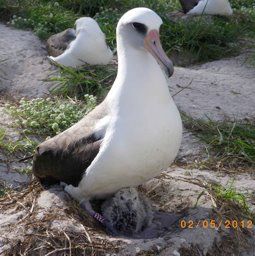Robert Henry (University of California, Santa Cruz, USA) has been awarded his PhD for a study of range expansion of the ACAP-listed Laysan Albatross Phoebastria immutabilis. Colonies studied included a Central Pacific site (Tern Island, North-western Hawaiian Islands, USA) and an Eastern Pacific site (Guadalupe Island, Mexico).
The thesis abstract follows:
"Little is known about large-scale breeding range expansions of top marine predators. I examined the effects of a recent range expansion on the ecology of the Laysan Albatross (Phoebastria immutabilis). Laysan Albatrosses recently expanded from historical breeding colonies in the Central Pacific Ocean to the Eastern Pacific Ocean, leading to a shift from colonies located adjacent to the productive North Pacific Transition Zone in the Central Pacific to colonies embedded within the eastern boundary current upwelling system of the Eastern Pacific California Current. I combined electronic tagging, remote sensing, reproductive monitoring, diet, stable isotope, and contaminant burden data to quantify the effects of range expansion on Laysan Albatross ecology in their historic and new ranges. I found that Central Pacific and Eastern Pacific Laysan Albatrosses maintain near complete range segregation during the breeding season but were less segregated during the post-breeding season. I used a Maximum Entropy model to rank the importance of a sweet [sic!] of environmental variables for each population. Chlorophyll-a was highest for Central Pacific albatrosses, which use the large North Pacific Transition Zone and sea surface temperature ranked highest for Eastern Pacific birds who utilized the biologically rich California Current System. The preferred habitat of Eastern Pacific albatrosses lies within closer proximity to the colony than that of Central Pacific albatrosses. In response, Eastern Pacific albatrosses had reduced foraging ranges, with decreased foraging trip length and duration, and spent more time on the water. Differences in distribution did not affect the tropic status of breeding albatrosses, where enrichment of 13C and 15N in the Eastern Pacific albatrosses (1.2‰ for δ13C; 3.4‰ for δ 15N) were due to geographic patterns in stable isotopes at the bottom of the food chain. This pattern did not hold for the most commonly consumed squid prey and precipitated further comparison 15N values between albatrosses and their prey. Results suggest that albatrosses are more trophically similar to fish than squid. I found contrasting patterns in exposure to marine contaminants with burdens of marine debris in the Central Pacific birds double that the burdens in Eastern Pacific albatrosses. This pattern reversed for persistent organic contaminant burdens, with Eastern Pacific birds having double the burdens of Central Pacific albatrosses. My data suggest that the variation in exposure to marine contaminants is reflective of ocean basin wide patterns in contaminant concentrations across the North Pacific and that proximity to aggregating oceanographic features and industrial centers are important routes of exposure. Finally, both fledging success and population growth of the Eastern Pacific colony is greater than that of the Central Pacific colony. These results and the apparent successful eastward colonization suggest that Laysan Albatrosses are buffered from environmental change by their ability to: move large distances, acquire similar prey resources, and reproduce successfully in contrasting habitats. These factors, combined with geographic trade offs in exposure to marine contaminants, indicate Laysan Albatrosses are well positioned to capitalize on this range expansion. This research is the first to contrast the consequences of a large-scale breeding range expansion on the ecology of a top marine predator. Results are important to understanding how organisms may respond to increases in anthropogenic stressors such as climate change."

Laysan Albatross with its downy chick. Photograph by John Klavitter
Reference:
Henry III, R.W. 2011. Consequences of range expansion in Laysan Albatrosses. PhD, University of California, Santa Cruz, USA. 152 pp.
John Cooper, ACAP Information Officer, 1 September 2012

 English
English  Français
Français  Español
Español